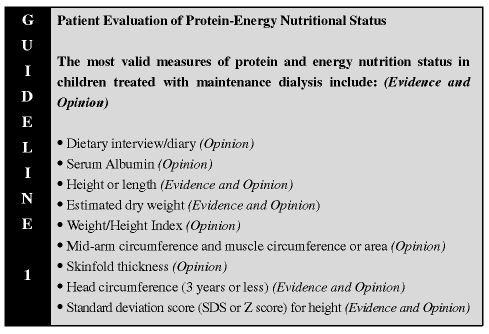

Assessment of the nutritional status of children receiving MD utilizes standard techniques from both normal children and adult dialysis populations. Monitoring energy and protein status in dialysis patients requires multiple indices measured concurrently and evaluated collectively. No single measure has been proven to provide a complete picture of protein-energy status in children treated with dialysis. The role of serum albumin is described in Guideline 1 of the adult guidelines. Growth parameters are a fundamental component and must be measured according to standardized protocols with consistent equipment and are preferably performed by the same person.14
The following parameters are directly measured: recumbent length, height, weight, head circumference, mid-arm circumference (MAC), and skinfold thickness. Formulas for calculating mid-arm muscle circumference (MAMC) and area and standard deviation scores (SDS) for height are included in Appendix I, along with tables of normal values. The Work Group was unable to agree on the optimum frequency for calculating SDS scores for weight. However, tables for calculating such scores are provided in Appendix I.
Dietary intake data provide a quantitative and qualitative analysis of the nutrient content of the diet. There are several limitations to using dietary recalls and diaries to assess protein and/or energy intake; however, they are the only component of the nutrition assessment by which actual nutrient intake can be evaluated. The validity and reliability of the diet information obtained from the patient depends on the accuracy of the nutrient intake data and the extent to which it represents typical eating patterns. Registered Dietitians (RDs) are skilled and well trained in obtaining dietary information and are able to educate patients on providing an accurate record of their food intake. The nutrient intake data is calculated for amounts of macronutrients and micronutrients and then used to develop or evaluate compliance with the diet prescription.
The most common methods for obtaining dietary intake data are the 24-hour dietary recall and the 3-day food record. An advantage of the recall method is that the respondent (child or family member) will not have the opportunity to deliberately modify his or her usual food behavior. Disadvantages include the potential for inability to remember details and quantities of foods, and the day in question may not represent typical intake. Food intake records are written reports of foods eaten during a specified length of time, typically 3 days. Records kept for more than 3 days increase the likelihood of inaccurate reporting. Inclusion of 1 weekend day is recommended. Food records must be very detailed, especially with regard to quantities of foods, to increase their validity. They are more time-consuming for both the patient and dietitian, but provide a more accurate assessment of dietary intake than the 24-hour recall.
The dietary interview should be conducted with the patient and/or primary caretaker by an experienced RD to obtain the following information: dietary intake data; presence or absence of nausea, vomiting, diarrhea, or constipation; consumption of non-food items such as paper or dirt; compliance with medication intake; eating patterns (availability and consumption) at school, home, and daycare; who prepares food for the family; facilities for food preparation; presence of economic resources for food purchasing; frequency of eating away from home (fast food, other restaurants); previous diet restrictions; change in appetite or the taste of food; mouth pain or difficulty swallowing; physical eating skills; and activity level. The information from the food recall or diary can be quantified for calorie and protein levels. The condition of the hair, nails, skin, tongue, teeth, and breath may give additional information about the patient's nutritional status.14 Children on dialysis require nutrition evaluation by a renal dietitian with skills in age-appropriate data collection and interpretation, counseling, monitoring, and modifying treatment goals on a regular basis.
Each child must be evaluated individually with regard to the degree to which serum albumin reflects nutritional status. Many factors affect serum albumin levels, including decreased synthesis secondary to inflammation, infection, malnutrition, acidosis, hormonal influences, and liver disease; increased losses due to peritoneal losses, persistent proteinuria, and blood loss; and altered distribution secondary to overhydration.15 Albumin used as blood pressure support during HD or in the treatment of nephrotic syndrome may falsely raise albumin levels.
A number of other measures to assess nutritional status were considered by the Work Group, including pre-albumin, body mass index (BMI), protein equivalent of total nitrogen appearance (PNA), alpha-1-acid glycoprotein (α1-AG), IGF-I, and dual energy x-ray absorptiometry (DXA). The reasons for not accepting these as valid measures of assessment at this time fell into the following categories: (1) lack of information on interpretation in renal disease; (2) inadequate standardization in children; (3) not responsive to the fluid compartment changes of growing children; and/or (4) impractical for clinical practice (eg, expensive facilities required, extensive expertise required to interpret, or substantial patient cooperation required). Normal values for BMI (weight in kilograms divided by height in meters squared) in children are to be included in new growth charts set to be released in 2001, or later, and may be recommended for inclusion in a standard nutrition assessment at that time.
Reasons for assessing protein and energy status more frequently include:
The expected result would be implementation of a plan to achieve or surpass recommended levels of protein and energy using foods normally consumed or nutritional supplements.